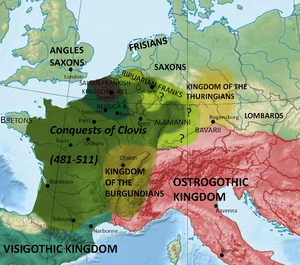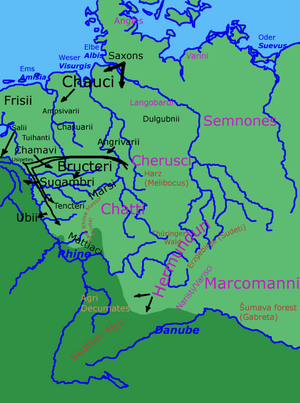Frisii
| Author:Laxman Burdak, IFS (R) |


Frisii were an ancient Germanic tribe[1] living in the low-lying region between the Rhine–Meuse–Scheldt delta and the River Ems, and the presumed or possible ancestors of the modern-day ethnic Dutch.
Variants
Jat clans
History
The Frisii lived in the coastal area stretching roughly from present-day Bremen to Bruges, including many of the smaller offshore islands. In the 1st century BC, Romans took control of the Rhine delta but Frisii to the north of the river managed to maintain some level of independence.[3] Some or all of the Frisii may have joined into the Frankish and Saxon peoples in late Roman times, but they would retain a separate identity in Roman eyes until at least 296, when they were forcibly resettled as laeti [4] (i.e., Roman-era serfs) and thereafter disappear from recorded history. Their tentative existence in the 4th century is confirmed by archaeological discovery of a type of earthenware unique to 4th-century Frisia, called terp Tritzum, showing that an unknown number of Frisii were resettled in Flanders and Kent,[5] likely as laeti under the aforementioned Roman coercion.
The lands of the Frisii were largely abandoned by c. 400, probably due to climatic deterioration and flooding caused by sea level rise. They lay empty for one or two centuries, when changing environmental and political conditions made the region habitable again. At that time, settlers that came to be known as Frisians repopulated the coastal regions. Medieval and later accounts of 'Frisians' refer to these 'new Frisians' rather than to the ancient Frisii.[6]
Description
What little is known of the Frisii is provided by a few Roman accounts, most of them military. Pliny the Elder (AD 23–79) said their lands were forest-covered with tall trees growing up to the edge of the lakes.[7] They lived by agriculture[8]and raising cattle.[9] In the late 1st century the Romans referred to the 'Greater Frisii' as living to the east of the lake Flevo, and the 'Lesser Frisii' to the west of it, so-called for their proportional power, and with the settlements of both stretching along the border of the Rhine to the ocean.[10]
In his Germania Tacitus would describe all the Germanic peoples of the region as having elected kings with limited powers and influential military leaders who led by example rather than by authority. The people lived in spread-out settlements.[11] He specifically noted the weakness of Germanic political hierarchies in reference to the Frisii, when he mentioned the names of two kings of the 1st century Frisii and added that they were kings "as far as the Germans are under kings".[12]
Early Roman accounts of war and raiding do not mention the Frisii as participants, though the neighboring Canninefates (to the west and southwest, in the delta) and Chauci (to the east) are named in that regard. The earliest mention of the Frisii tells of Drusus' 12 BC war against the Rhine Germans and the Chauci. The Romans did not attack them after devastating the lands of the Rhine Germans, but merely passed through their territory and along their coast in order to attack the Chauci. The account says that the Frisii were "won over", suggesting a Roman suzerainty was imposed.[13]
Over the course of time the Frisii would provide Roman auxiliaries through treaty obligations, but the tribe would also appear in its own right in concert with other Germanic tribes, opposing the Romans. Accounts of wars therefore mention the Frisii on both sides of the conflict, though the actions of troops under treaty obligation were separate from the policies of the tribe.
Final demise of the ancient Frisii
The emperor Constantius Chlorus campaigned successfully against several Germanic peoples during the internecine civil wars that brought him to sole power over the Roman Empire. Among them were the Frisii and Chamavi, who were described in the Panegyrici Latini (Manuscript VIII) as being forced to resettle within Roman territory as laeti (i.e., Roman-era serfs) in c. 296.[14] This is the last reference to the ancient Frisii in the historical record. However, they appear once more, now in the archaeological record. The discovery of a type of earthenware unique to 4th century Frisia known as terp Tritzum shows that an unknown number of them were resettled in Flanders and Kent[15], likely as laeti under the aforementioned Roman coercion.
If there were any Frisii left in Frisia, they fell victim to the whims of nature, civil strife and piracy. After several hundred years of favorable conditions, the natural environment in the low-lying coastal regions of northwestern Europe began to deteriorate c. 250 AD and gradually worsened over the next 200 years. Rising sea levels and storm surges combined to flood some areas. Many deserted village sites were silted over. The situation was probably aggravated by a shift to a cooler, wetter climate in the region as well as by the introduction of malaria and other epidemic diseases.[16][17]
In the 3rd and 4th centuries the population of Frisia steadily decreased, and by the 5th century it dropped dramatically. Archaeological surveys indicate that only small pockets of the original population stayed behind (e.g. in the Groningen coastal marshes).[18] The coastal lands remained largely unpopulated for the next one or two centuries. As soon as conditions improved, Frisia received an influx of new settlers, mostly from regions later characterized as Saxon, and these would eventually be referred to as Frisians, though they were not necessarily descended from the ancient Frisii. It is these 'new Frisians' who are largely the ancestors of the medieval and modern Frisians.[19] Their Old Frisian language, however, was more intricately related to Old English spoken by their relatives settling abroad, than to the Old Saxon language spoken by the people staying behind in Germany.
See also
External links
References
- ↑ Drinkwater, John Frederick (2012). "Frisii". In Hornblower, Simon; Spawforth, Antony; Eidinow, Esther (eds.). The Oxford Classical Dictionary (4 ed.). Oxford University Press. ISBN 9780191735257.
- ↑ Bhim Singh Dahiya, Jats the Ancient Rulers (A clan study)/Appendices/Appendix II, p.329
- ↑ Minahan, James (2000). One Europe, many nations : a historical dictionary of European national groups. Westport, Conn: Greenwood Press. p. 264. ISBN 9780313309847.
- ↑ Grane, Thomas (2007), "From Gallienus to Probus - Three decades of turmoil and recovery", The Roman Empire and Southern Scandinavia–a Northern Connection! (PhD thesis), Copenhagen: University of Copenhagen, p. 109
- ↑ Looijenga, Jantina Helena (1997), "History, Archaeology and Runes", in SSG Uitgeverij (ed.), Runes Around the North Sea and on the Continent AD 150–700; Texts and Contexts (PhD dissertation) (PDF), Groningen: Groningen University, p. 40, ISBN 90-6781-014-2. Looijenga cites Gerrets' The Anglo-Frisian Relationship Seen from an Archaeological Point of View (1995) for this contention.
- ↑ Bazelmans, Jos (2009), "The early-medieval use of ethnic names from classical antiquity: The case of the Frisians", in Derks, Ton; Roymans, Nico (eds.), Ethnic Constructs in Antiquity: The Role of Power and Tradition, Amsterdam: Amsterdam University, pp. 321–337, ISBN 978-90-8964-078-9
- ↑ Pliny the Elder 79b:340–341, Natural History, Bk XVI Ch 2: Wonders connected with trees in the northern regions.
- ↑ Tacitus 117:253, The Annals, Bk XIII, Ch 54. Events of AD 54–58. This was confirmed by Tacitus when he said that in an incident where the Frisii had taken over land, they then settled into houses, sowed the fields, and cultivated the soil.
- ↑ Tacitus 117:147–148, The Annals, Bk IV, Ch 72–74. Events of AD 15–16. Tacitus specifically refers to the herds of the Frisii.
- ↑ Tacitus & 98:61–62, The Germany, XXXV.
- ↑ Tacitus & 98:18–19, 23–24, 36–37, The Germany, Ch V, VII, XVI
- ↑ Tacitus 117:253, The Annals, Bk XIII, Ch 54. Events of AD 54–58.
- ↑ Lucius Cassius Dio Cocceianus (229), "Book LIV, Ch 32", in Cary, Earnest (translator) (ed.), Dio's Roman History, vol. VI, London: William Heinemann (published 1917), p. 365
- ↑ Grane, Thomas (2007), "From Gallienus to Probus - Three decades of turmoil and recovery", The Roman Empire and Southern Scandinavia–a Northern Connection! (PhD thesis), Copenhagen: University of Copenhagen, p. 109
- ↑ Looijenga, Jantina Helena (1997), "History, Archaeology and Runes", in SSG Uitgeverij (ed.), Runes Around the North Sea and on the Continent AD 150–700; Texts and Contexts (PhD dissertation) (PDF), Groningen: Groningen University, p. 40, ISBN 90-6781-014-2. Looijenga cites Gerrets' The Anglo-Frisian Relationship Seen from an Archaeological Point of View (1995) for this contention.
- ↑ Ejstrud, Bo; et al. (2008), Ejstrud, Bo; Maarleveld, Thijs J. (eds.), The Migration Period, Southern Denmark and the North Sea, Esbjerg: Maritime Archaeology Programme, ISBN 978-87-992214-1-7
- ↑ Issar, Arie S. (2003), Climate Changes during the Holocene and their Impact on Hydrological Systems, Cambridge: Cambridge University, ISBN 978-0-511-06118-9
- ↑ Knol, Egge (1993), De Noordnederlandse kustlanden in de Vroege Middeleeuwen, Groningen: PhD. University of Groningen
- ↑ Bazelmans 2009:321–337, The case of the Frisians.

